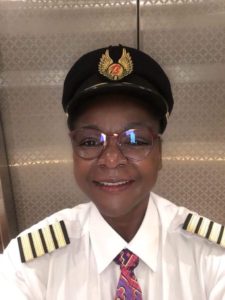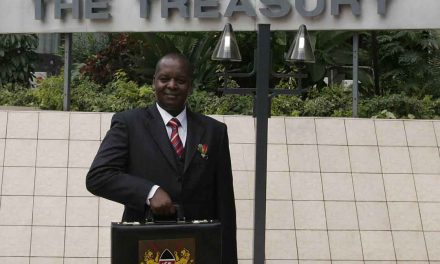
Botswanan Sakhile Reiling (left) became Air Botswana’s first female pilot
African women are world leaders when it comes to taking top jobs in the aviation industry
In December 2017, a Boeing 777 made African history when it flew five hours from Addis Ababa to Lagos, Nigeria with an all-female crew. Captain Amsale Gualu piloted the plane, with the help of women cabin crew, check-in attendants, flight dispatchers and ground staff. Captain Gualu told the world media on landing: “This flight shows us that if women get equal opportunities and work hard, I’m sure they can achieve whatever they want in all fields, including the aviation industry.”
Two years earlier, Air Zimbabwe flew an all-female domestic flight, making pilots Chipo Matimba and Elizabeth Petros the first female pilots to fly internally on Air Zimbabwe. The women took to social media: “History has been made! First all female flight deck crew on the Air Zimbabwe Boeing 737!”and “Two CAPTAINS!! #FLYBABES. #PaintingTheSkyPink!”.
These women-only flights were no accident; both airlines were making a point, pushing an agenda to encourage African women to think about the career possibilities available to them within the heavily male-dominated aviation industry. Women in aviation around the world make up at least 50% of personnel – mostly as cabin and ground crew. This figure dips dramatically as positions become more senior.
Figures recorded by the International Air Transport Association (IATA) show that less than 5% of airline CEOs are women. The figure for female pilots falls to between 3-5% worldwide. Women are less represented in aviation than in any other industry. But, not in Africa. An IATA meeting in Sydney in June this year announced that African airlines, and the aviation industry on the African continent, are bucking this trend.
Air Namibia’s acting managing director, Mandi Samson, told the conference that her airline had four top management positions filled by women. “For once, Africa is leading in something,” she said.
Samson is correct. In South Africa, for example, women hold significant positions. Poppy Khoza leads the critically important SA Civil Aviation Authority (SACAA) as its CEO, while Zuks Ramasia is general manager of operations at South African Airways (SAA). And it is now 20 years since Asnath Mahapa made history in 1988 by becoming South Africa’s first female African pilot.
But success has not come easily for the women at the top. For Mahapa, flight school came with challenges, and she remembers being “the only woman in my class and I had to work ten times harder than the men”. Since then, while the global average of women captaining aircraft stands at around 5%, the actual number of female pilots in South Africa is in the double digits. And the number of black female pilots is steadily growing across Africa, much more quickly than in the rest of the world.
The number of women in senior positions in the aviation industry in Africa has impressed the airline industry sufficiently to ensure that they are constantly called on to give motivational speeches or talk to aviation conferences.
Siza Mzimela is the recently appointed interim CEO of South African airline SA Express. She also has the distinction of being the first black woman in South Africa to start and own an airline, Fly Blue Crane. (The airline is no longer operating. It was suspended by IATA in September 2017 and bankruptcy proceedings are under way).
However, Mzimela’s list of accolades includes being the first black executive vice president of SAA as well as the first woman to make it onto the IATA board. Mzimela is not surprised that Africa ranks as having the largest number of women within the global aviation industry. But she points out that the numbers are coming off a ridiculously low base.
“There might be more women engaged in aviation on the African continent, including here in South Africa,” she told Africa in Fact, “but make no mistake; it’s the toughest environment for women and we have to work twice as hard as our male counterparts to prove ourselves. It is still challenging for women, and there is vast room for improvement. We need more women pilots and technicians and women in key organisational positions.”
Mzimela believes that the reason South African women in aviation have had more success than their global sisters is due to race rather than gender bias.
“When men have to promote someone, they choose one of their own,” she said. “Fortunately, and unfortunately, black men did not automatically come through as pilots. It was the preserve of white men for a long time and black men and black women were equally disadvantaged. We, therefore, are on a fairly equal footing regarding entry into the aviation field, and therefore we have a better chance of getting into the industry.”
Mzimela points out, however, that while 50% of South Africans are women, the number of CEOs and captains of industry does not reflect that split. “We need an aviation policy to correct the imbalances of the past. In this industry, there is a low turnover of pilots – nobody leaves until they retire. That has meant that transformation will take longer because it will take longer for pilots to work their way up the chain of seniority.”
Khoza notes that an “overdue dialogue” to improve the numbers of women in the African aviation industry has begun. “This assertion was corroborated by women from various corners of the world during discussions at the first-ever Global Aviation Gender Summit hosted by SACAA,” she told Africa in Fact.
“Close to 500 top-ranking represen- tatives of the aviation industry – including airlines, aircraft manufacturers and airports, as well as governments from across the world – gathered in Cape Town in August [2018] to chart a new path that will bring about meaningful gender transformation and equality in aviation.”
“From our discussions,” Khoza said, “we heard that the challenges of a female aviator in Chile are the same as those faced by a female aviator in China. It was encouraging to note that everyone at the summit agreed that the status quo cannot continue unchallenged. In South Africa, in particular, we are witnessing some improvement, even though women still constitute less than 10% of aviation technical personnel.’’
More young women, Khoza insists, have to join the ranks of other pioneers who “trounced gender and racial stereotypes to make it in the aviation industry. We do have success stories and each one of them deserves recognition and acknowledgement.”
Refilwe Ledwaba is one of those success stories. She is a pilot, a flight instructor, and the first black woman in South Africa to fly helicopters. In 2009, she also started a non-profit organisation for young women in the SADC countries, Southern African Women in Aviation and Aerospace Industry (SAWIA). “I wanted to ensure that the aviation industry provided a platform for women to grow, to find mentorship and guidance and to fund the opportunities for young women who wish to join the sector in the future.”
Ledwaba introduced the Girl Fly Programme in Africa, aimed specifically at high school girls. The non-profit organisation, endorsed by the SACAA, has an informal database of about 1,000 members from all over the Southern African Development Community (SADC). “I’m passionate about the development of women, which is why I saw the need for such an organisation,” Ledwaba told Africa in Fact.
It all started when, on a flight to Cape Town, she heard the woman piloting the plane, Captain Margaret Viljoen, say: “This is your captain speaking”. “Until then, I had not even considered that a woman could fly a plane!” she said.
Botswanan Sakhile Reiling, who became Air Botswana’s first female pilot back in 1988, now describes herself as “an aviation consultant (with Saxon Wings Aviation Consultants) as well as an aviation safety auditor currently involved with a number of significant clients around the world. I travel to where the work is.” Reiling’s career includes two years spent as CEO at Botswana Air and five years in senior management positions at Comair. She also spent time as the GM of Air Safety Operations at SACAA and spent five years in senior managerial posts at SA Express Airways.
“Africa has made significant progress in ensuring that women are not overlooked for aviation-related jobs,” she told Africa in Fact. “However, more still needs to be done to dismantle legacy practices that continue to hamper growth. For example, support is required at policy level to mandate current industry players to play greater roles in accepting women within their various organisations.”
Reiling agrees with other female aviation executives that young women must be exposed from an earlier age to the possibilities of an aviation career. “Many do not realise that they too could enter the aviation industry and contribute in an important way,” she said.
Zuks Ramasia, GM of operations at SAA, believes it is up to women to help women in aviation.
“In aviation, most opportunities for women in meaningful management echelons are still determined mainly by men since there are few women in senior roles to influence and motivate women in junior positions across the value chain,” she told Africa in Fact. She blames the high attrition rate on the promotion limitations placed on women with potential.
“We, the women in influential positions, need to mentor and coach women, challenge the status quo and not be deterred by the men in office who often pretend we do not exist.”
“As women in the industry we need to stand together to promote awareness, to develop, to nurture, to celebrate and to empower women in our industry, starting by shaping young minds at school.”
Khoza points out her success rate at helping achieve parity. “In the organisation that I lead, when I took over, the executive management committee was male dominated. Five years later, 50% of the executive is female and black. It starts at grassroots level.”
SACAA funds the training of young South Africans, especially female students from economically deprived households, who want to become aviators.
“Transformation is not a responsibility of government and regulators such as the SACAA only,” Khoza said, “but a collective responsibility of all, including the business sector. Transformation is a moral obligation and a human rights issue that should not be limited to race only but extended to gender and business opportunities.”
Stereotyping, she said, is the hardest challenge that women face in aviation, “coupled with unconscious bias”.
“The picture that people imagine of a pilot is not likely to be that of a Captain Boitumelo or Fatima in the cockpit. Our young girls cannot picture themselves following in the footsteps of women pioneers in the aviation sector primarily because aviation is still seen as a preserve for men.
“What then becomes important is the socialisation of young girls, to instill a belief that they can be anything they want to be. We need to move away from creating a mindset of categorising industries based based on gender.
Young girls can be aeronautical engineers, they can be air-traffic controllers, they can successfully pilot any aircraft of their choice. However, the limiting mindset, which we instill in them at a young age, only perpetuates the stereotypes, which we must demystify.”
In 2017, 26-year-old Second Lieutenant Thokozile Muwamba broke another glass ceiling when she became Zambia’s first female fighter pilot. She told the BBC her ambition was to become the first female Zambian air force commander. “Wow, to be in the air… it feels… it’s wonderful,” she told the broadcaster then. “You feel like you don’t want to come back onto the ground.”
Muwamba joined the military in 2012 and was chosen to be part of a Zambian airforce programme specifically designed to shift the gender bias towards men.
She told the Times of Zambia: “Women should begin to participate and realise their abilities. Because I understand this, I am ready to undertake this task ahead of me.”
And she is not the only woman who’s taken to the skies as part of her country’s airforce. Lieutenant Ouma Laouali, 31, became Niger’s first female pilot in 2015. As a member of the Nigerien airforce, she was trained by the United States to help in the fight against the terrorist organisation Boko Haram.
The women who are important in Africa’s aviation industry are clearly united in what they see as the way forward: expose young women to the world of flying and work tirelessly to reverse the stereotyping that has discouraged young women from taking flight, accompanied by policies to facilitate transformation.











